Affiliate disclosure: This post may contain affiliate links. Please see our Privacy Policy.
Aronia Berries, also known as Black Chokeberry (Aronia melanocarpa) is a nutrient-dense wild edible berry that’s gotten a lot of press recently as a great source of antioxidants. They’re not cultivated commercially in some areas, but they’re still available for wild foraging across the US.
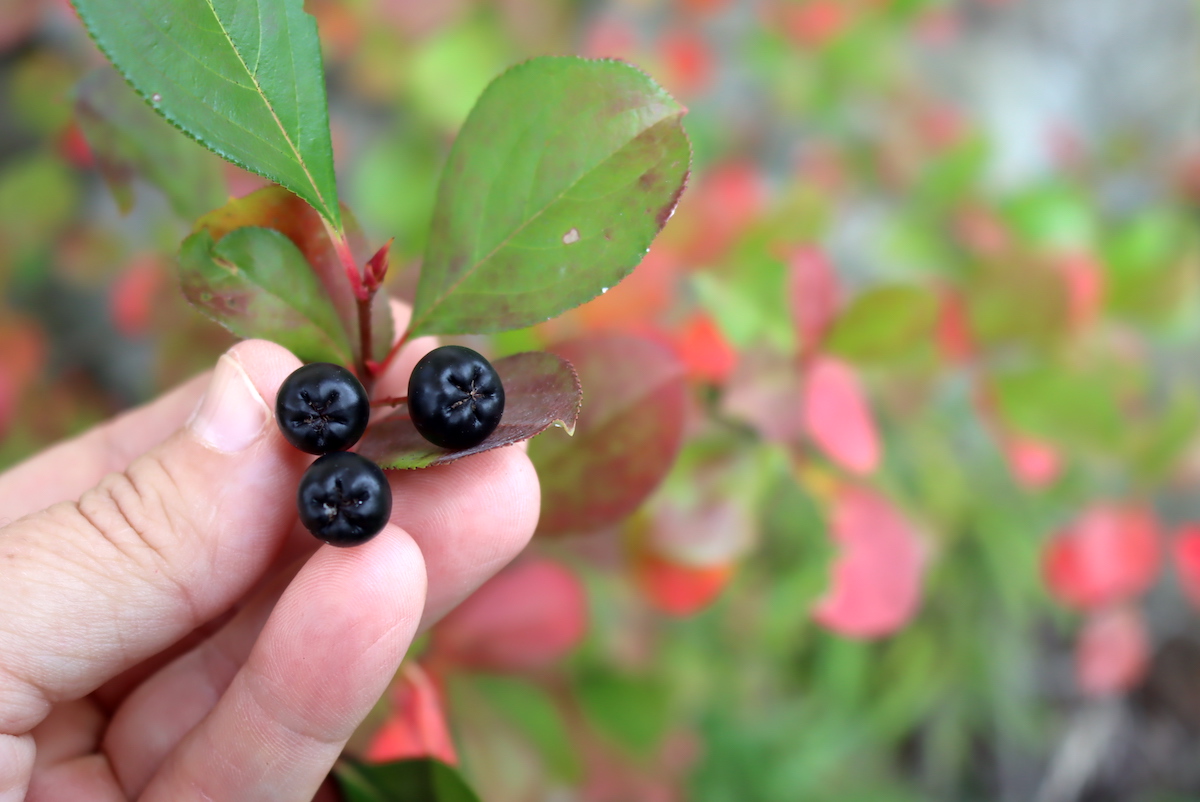
Several species of Aronia berries are cultivated and marketed as superfoods, but their wild cousins are out there free for the taking. Black Chokeberry (Aronia melanocarpa) is native to the Eastern half of the US and Canada (map here), and though the name sounds similar to chokecherry, they’re completely different plants.
In urban areas, they’re common in landscape plantings, and our local Trader Joe’s grows in ditches throughout the parking lot. They produce beautiful flowers in the spring, and the berries are just ripening in the early fall as the foliage puts on a beautiful show.
I’d never heard of Aronia until I spotted a few plants at a local permaculture nursery that caries more exotic edible plants. The tag said “beautiful native shrub with edible berries, a good choice for wet soils.”
Much of our land is wet, and I’m always looking to supplement our permaculture plantings with edible fruit. Once I’d had the chance to watch my plantings for a full year, I started seeing black chokeberry bushes everywhere!
That goes to show you, if you really want to learn to identify a new wild edible, just try growing it. You’ll have a chance to watch it throughout the seasons, which makes it a lot easier to spot in the wild.
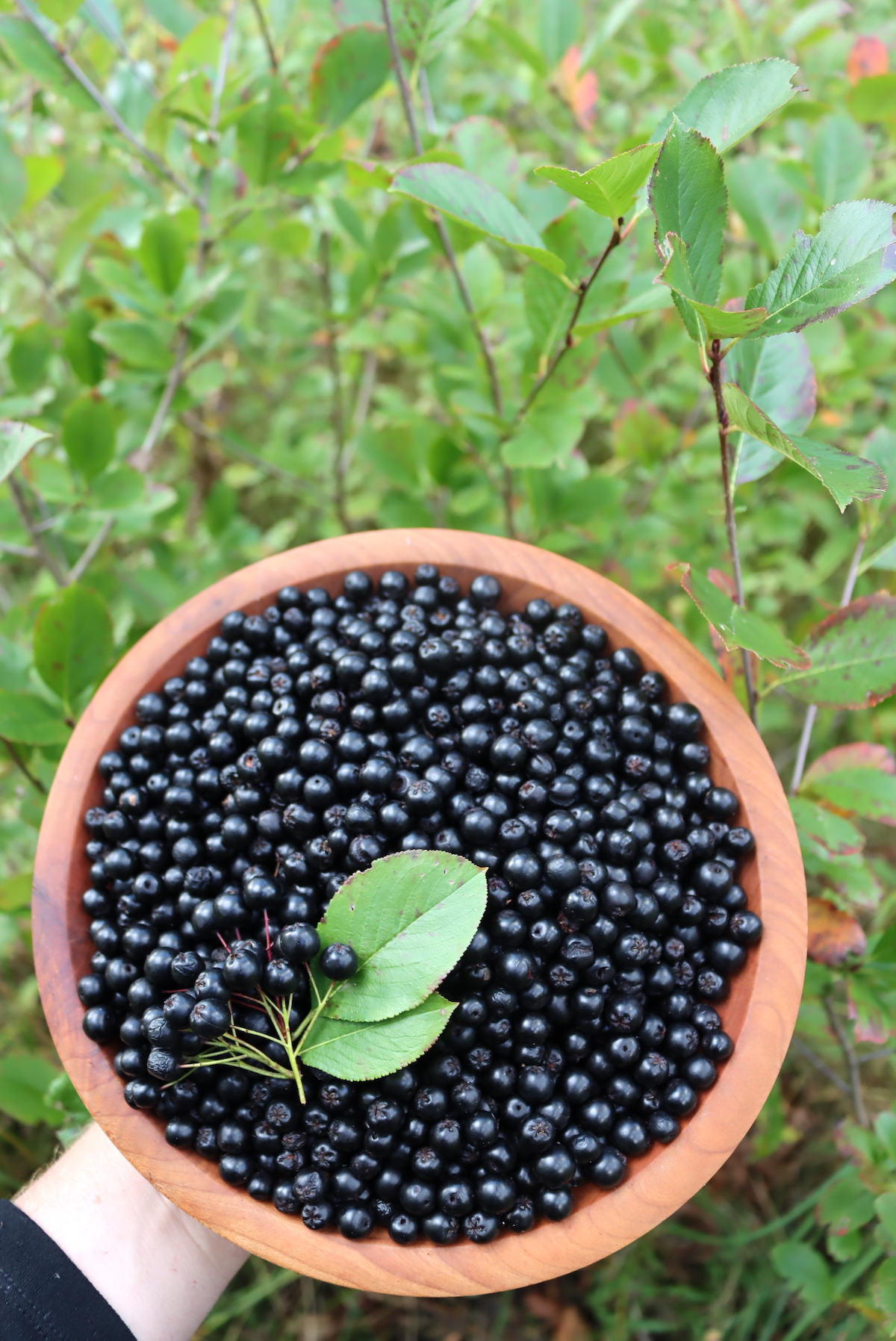
What is Black Chokeberry?
Black Chokeberry, or Aronia melanocarpa, is a perennial deciduous shrub in the Rose or Rosaceae family. It’s known by a couple of common names, including Chokeberry and Black Berried Aronia.
Black Chokeberry is native to eastern North America. You may it from Newfoundland west to Ontario and south as far as Arkansas and Georgia. It has also naturalized in parts of Europe and Eastern Asia.
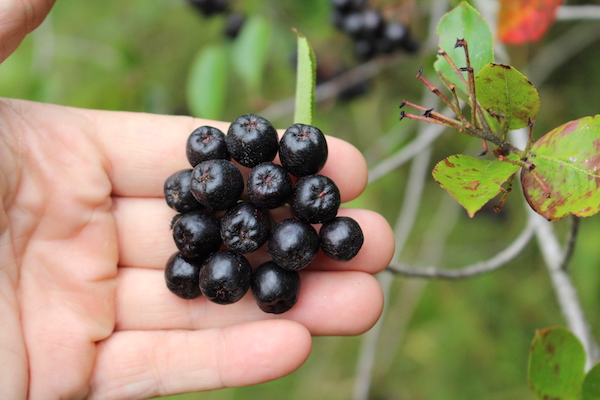
Is Chokeberry Edible?
It has a scary name, but Black Chokeberry berries are edible and healthy! They get their name because they are quite astringent when eaten raw. For this reason, foragers typically cook them in various sweetened recipes before eating them.
There isn’t much information available on the edibility of the leaves and flowers, so at this point, it’s probably best just to harvest the berries.
Be aware that the fruit has a rich purple juice that will stain your hands (like elderberries), and they’re even used as a wild dye source. You may end up with purple hands, but it’s worth it.
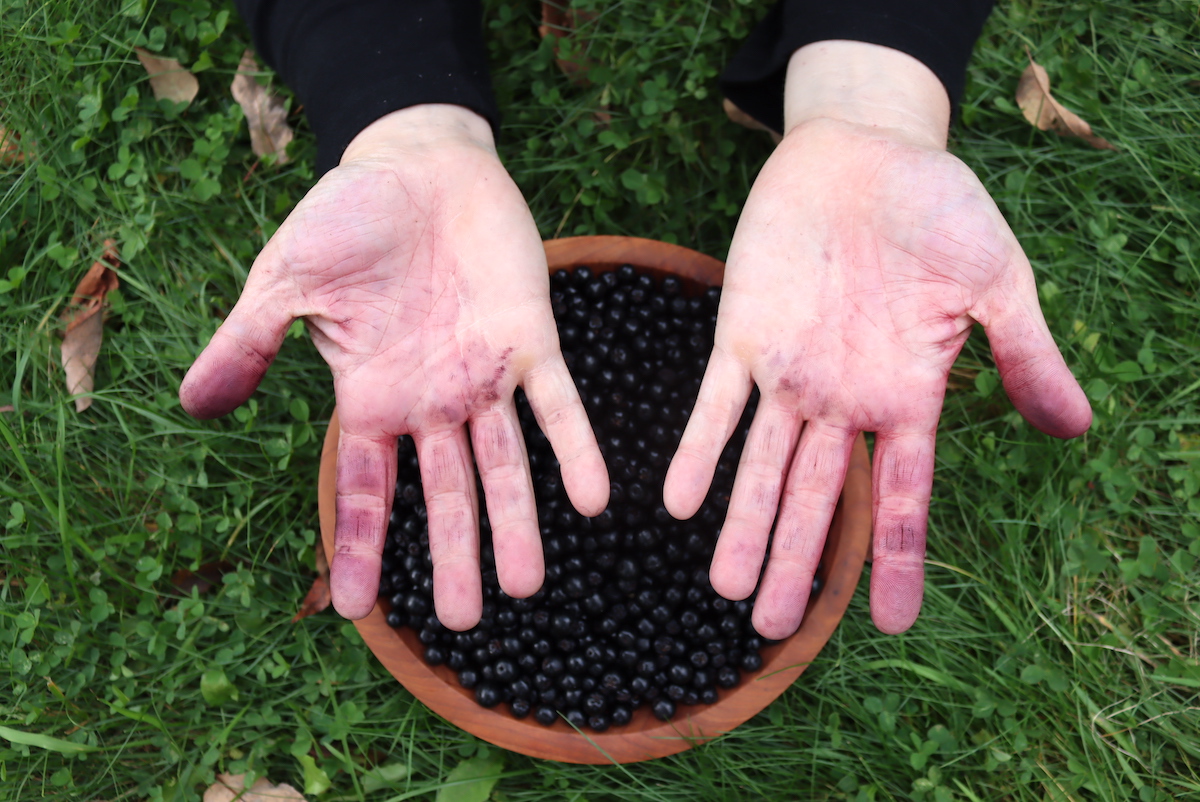
Black Chokeberry Medicinal Benefits
Native Americans were the first people to explore the benefits of Black Chokeberry. The berries were an important food source, and they also used them to make tea for treating colds. They also used the bark as an astringent herb.
Today, Black Chokeberry remains a surprisingly popular herbal remedy despite not being used often in food. In clinical studies, Black Chokeberry juice, extracts, and vitamin supplements display antioxidative, anti-inflammatory, hypotensive, antiviral, anticancer, antiplatelet, antidiabetic, and antiatherosclerotic activities. The berries are also high in Vitamin C, fiber, and anthocyanins, giving them their dark color.
A particular study examined Black Chokeberry’s ability to prevent recurring UTIs. The study found that long-term consumption of Black Chokeberry juice reduced the incidence of recurring UTIs in nursing home patients, who are particularly vulnerable to this issue.
Some of Black Chokeberry’s anticancer properties have also been tested. One study found that Black Chokeberry extract reduced cell proliferation (growth and division) in human colon cancer cells.
Additionally, Black Chokeberries have been shown to have numerous benefits for heart health. One study found that daily supplementation with Black Chokeberries reduced blood pressure and cholesterol, especially in individuals over 50 years old.
While most scientists note that more research is still needed, Black Chokeberries have displayed many potential health benefits with no reported adverse side effects.
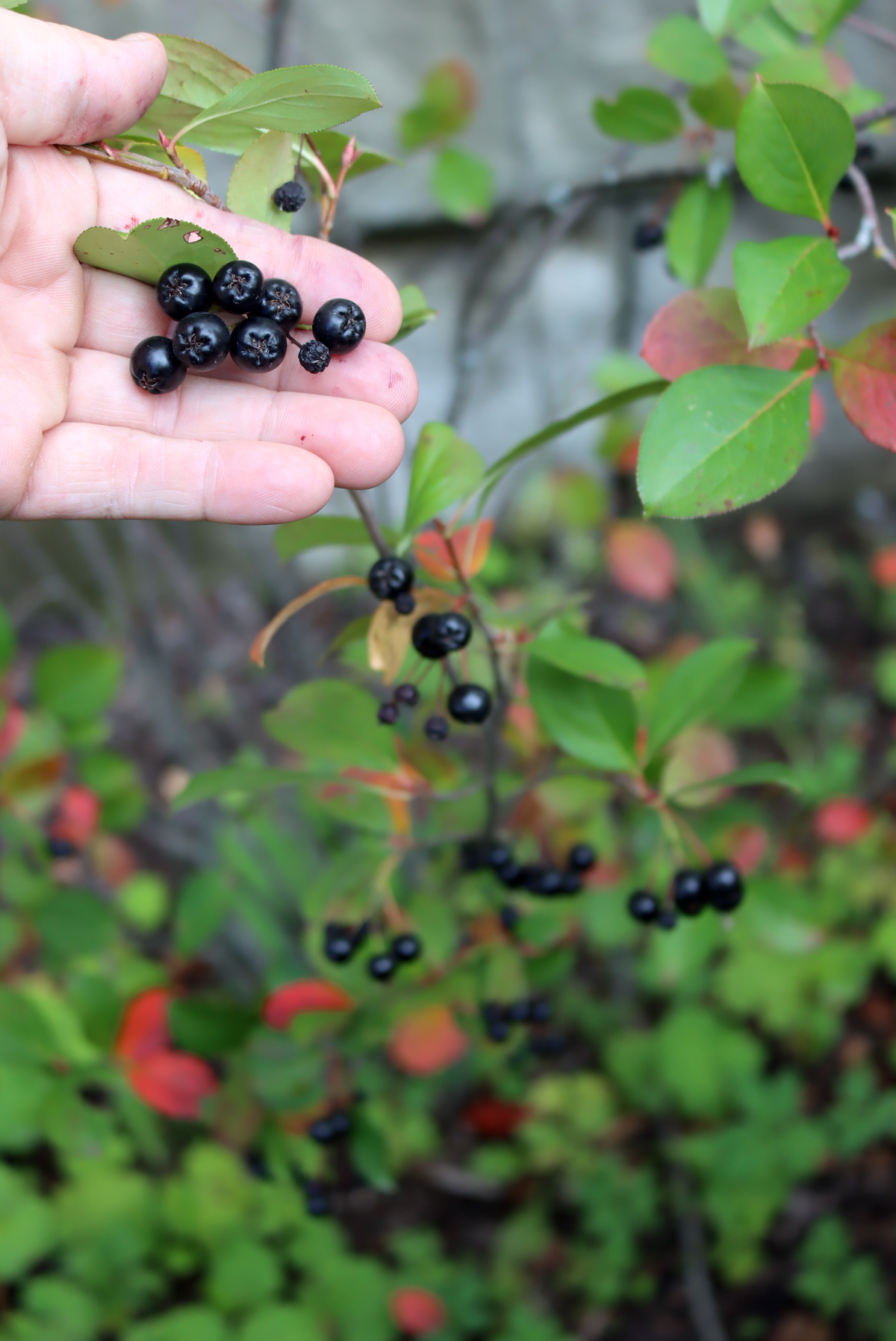
Where to Find Black Chokeberry
Black Chokeberry grows throughout eastern North America. You can find it growing in Canada from Newfoundland west to Ontario and south into the United States as far as Arkansas and Georgia. Black Chokeberry has also naturalized in parts of Europe and eastern Asia.
Black Chokeberry thrives in moist to wet, acidic soils. It’s highly adaptable and can grow in sand, clay, or loam soils. It even tolerates compacted soil, salt, and occasional drought or flooding.
Black Chokeberry will grow in partial shade to full sun. Black Chokeberry shrubs in areas that receive full sun typically produce more fruit.
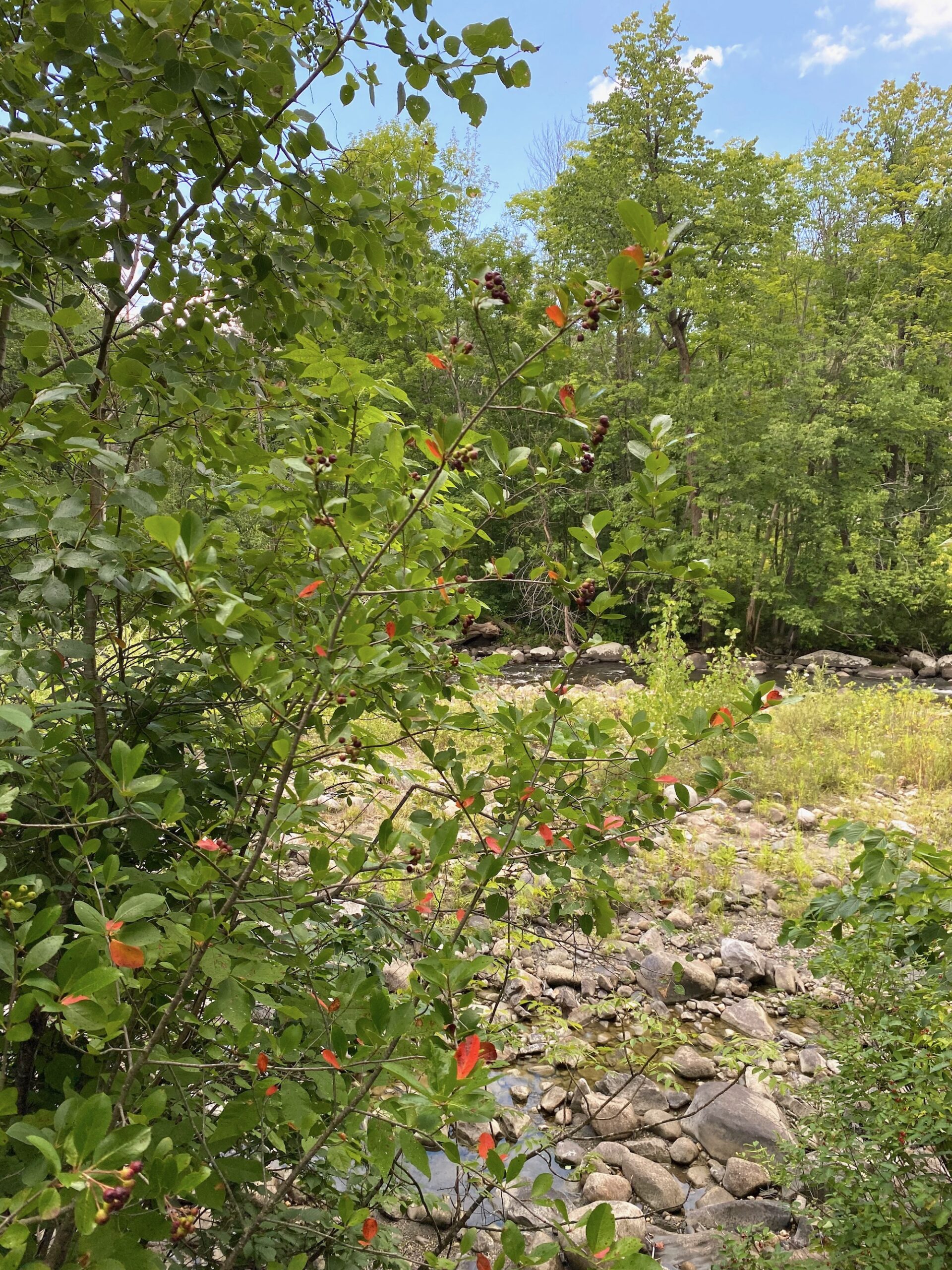
When to Find Black Chokeberry
You can identify Black Chokeberry year-round if you know what you’re looking for. However, they are easiest to find in summer. Black Chokeberries are deciduous, so they drop their leaves in the fall. Their showy white flower clusters usually appear from April to June and last several weeks. Those farther south will spot flowers earlier than those in the north.
The berries begin forming in early summer, after the plant flowers. They’re green at first but ripen to purplish-black or black in later summer or early fall. Usually, this occurs in August in southern parts of its range and in September in northern regions. Many foragers believe the berries are the most highly nutritious and tasty after a frost.
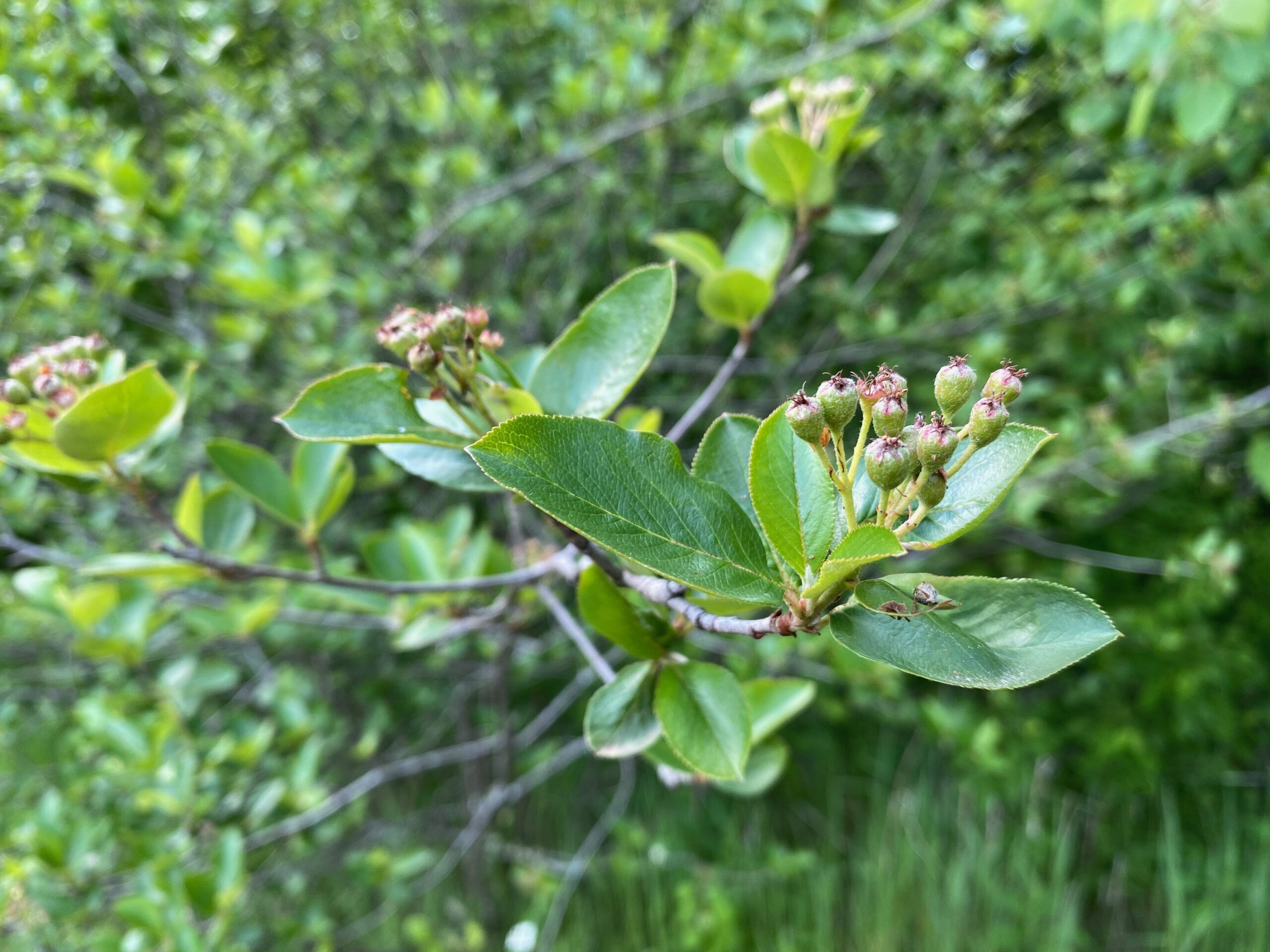
Identifying Black Chokeberry
Black Chokeberry is an upright, rounded shrub with dark green glossy leaves. It’s common to spot Black Chokeberry growing in thick patches as it can reproduce through root suckers, especially in favorable conditions. These root suckers allow the patch to quickly expand and outcompete other shrubs in the immediate area.
It’s most notable when it’s in fruit or flower. You may spot its attractive clusters of white flowers or its downward hanging clusters of berries, which ripen to purplish-black or black.
Black Chokeberry Leaves
Black Chokeberry has alternate, finely-toothed, glossy green leaves. The leaves are elliptical to obovate and 1 to 3 inches in length. In the fall, the leaves change to vibrant shades of red, orange, and purple before dropping.
Black Chokeberry Stems
Black Chokeberry shrubs can have multiple stems and may reach 3 to 8 feet tall. The stems have relatively smooth dark gray or dark brown bark with conspicuous lenticels (a type of raised pore). The bark on young twigs appears different from mature bark. Twigs typically start out green and mature to reddish and then purplish brown.
Black Chokeberry produces new stems, called root suckers, as a reproduction method. These shoots come off the original plant’s root and form a clone.
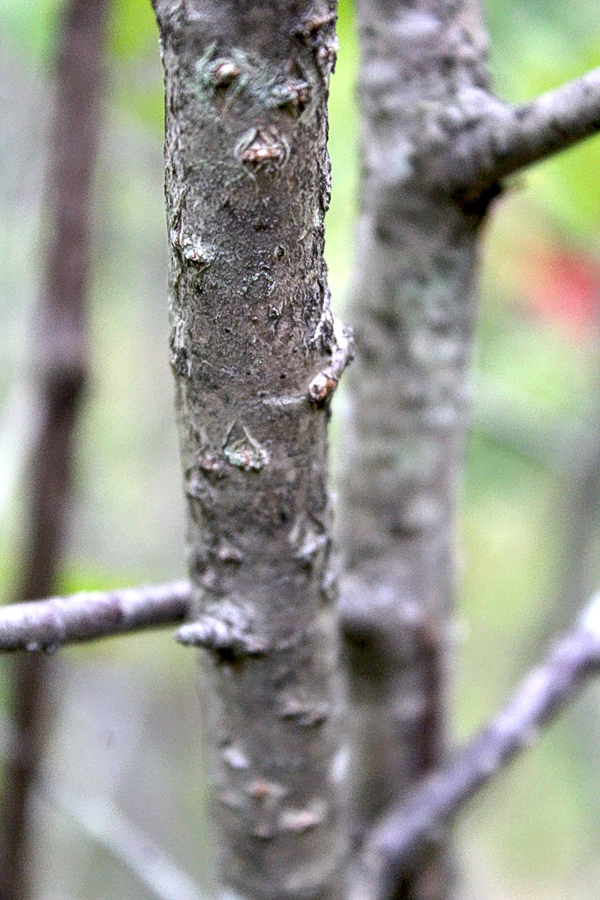
Black Chokeberry Flowers
In the spring or early summer, between April and June, Black Chokeberry produces attractive, 2 to 3-inch clusters of white flowers with showy pink anthers. Each cluster generally contains 5 to 6 flowers. Individual flowers have five petals and are about 0.3 inch in diameter.
Black Chokeberry Fruit
After flowering, Black Chokeberry produces clusters of berries attached to the main branch by a single stem. Immature berries are green but mature to purplish-black or black in late summer or autumn, typically in August or September. Each berry is usually 0.25 to 0.5 inches in diameter and contains 1 to 5 small seeds.
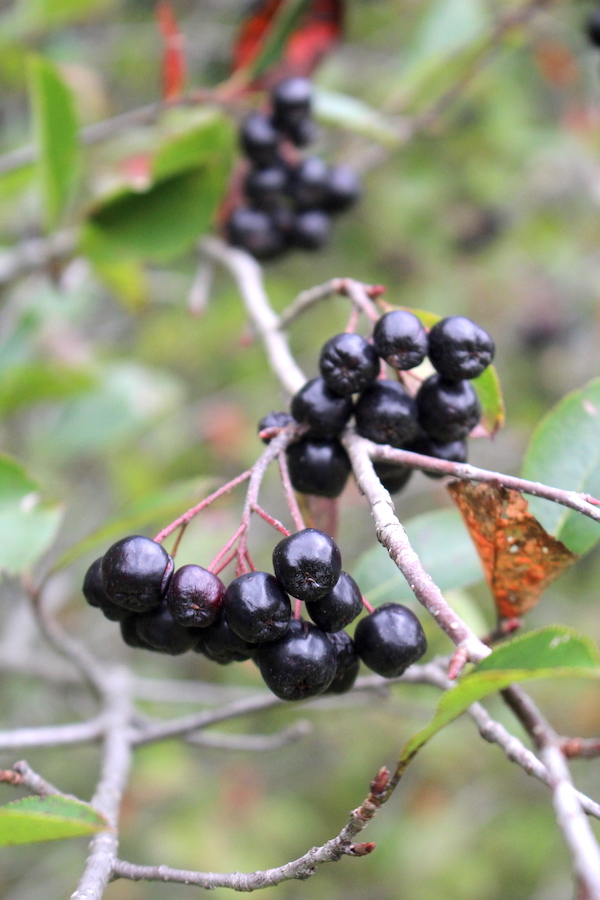
Black Chokeberry Look-Alikes
Black Chokeberry is sometimes mistaken for Common buckthorn (Rhamnus cathartica). However, Common Buckthorn differs in several noticeable ways:
- Common Buckthorn has spines on its branches.
- Common Buckthorn has opposite or sub-opposite leaves, meaning the leaves may be slightly offset but not enough to be alternate.
- Common Buckthorn has yellowish or yellowish-green flowers.
- Common Buckthorn berries appear to be in a cluster, but on close examination, each berry has a stem that attaches to the main branch.
Another look-alike is the similarly named and edible Chokecherry (Prunus virginiana). However, it can be distinguished from Black Chokeberry in a couple of ways:
- Chokecherry is often a bit larger and may grow 20 to 30 feet tall.
- Chokecherry forms drooping, elongated flower clusters 3 to 6 inches long.
- Chokecherry flowers also have five petals but are generally larger, about 0.5 inches in diameter, and lack the showy pink anthers.
- Each Chokecherry berry contains a single large seed.
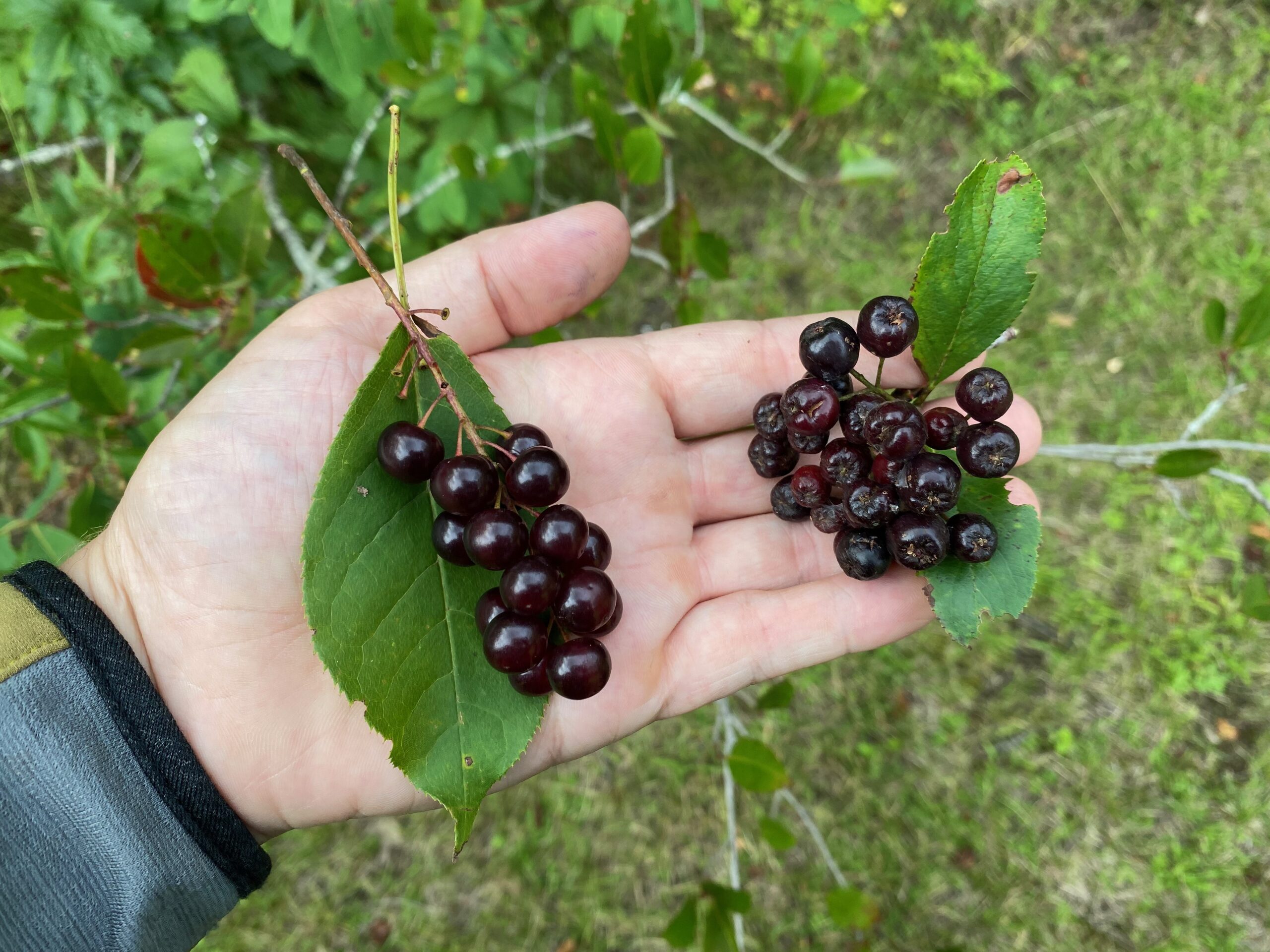
Another look-alike with edible berries is Black Cherry (Prunus serotina). Black Cherry can be distinguished from Chokeberry in the following ways:
- Black Cherry is a tree that can reach 40 to 60 feet tall with a crown 20 to 30 feet wide.
- Black Cherry bark tends to be dark, rough, and scaly on the trunk.
- Black Cherry leaves tend to be narrower and may be narrowly ovate or lanceolate-ovate.
- Black Cherry leaves have rounded teeth on their margins.
- Black Cherry berries are usually larger, ½ to 1 inch in diameter.
Lastly, Chokeberries may be confused with Shadbush or Serviceberry (Amelanchier spp.). However, these also differ in a few easy-to-spot ways:
- Shadbushes have leaves with downy undersides.
- Shadbush flower clusters form at terminal buds and are short-lived.
- Individual Shadbush flowers are produced from wooly buds.
- Shadbush leaves tend to be wider and are oval or rounded.
Ways to Use Black Chokeberry
Black Chokeberries don’t sound tasty and can be pretty astringent plain, but they are incredibly healthy and make a delicious addition to many recipes. One of the easiest ways to add Black Chokeberries to your diet is to drink them.
You can make sweetened Black Chokeberry juice or add them to smoothies with other fruit.
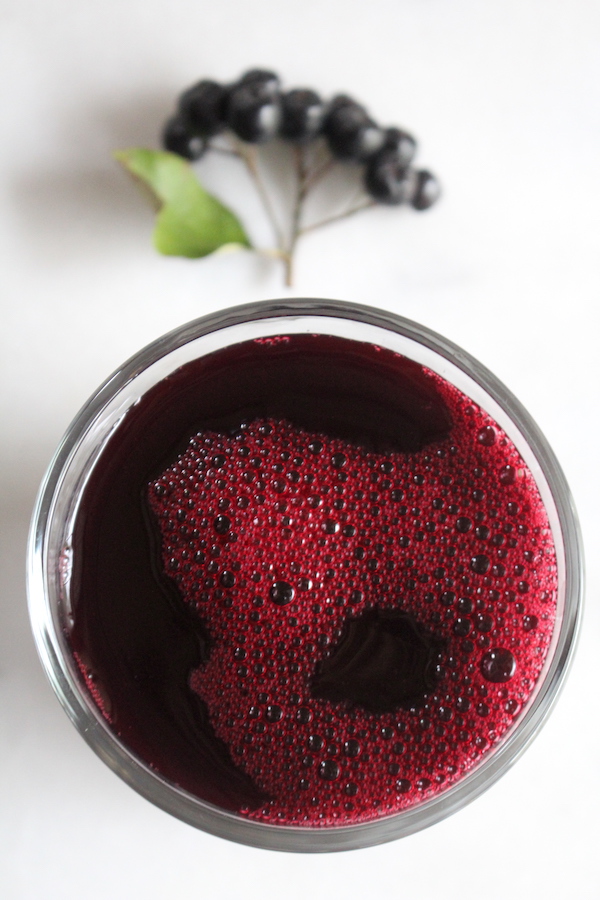
Black Chokeberries are also a great addition to baked goods and other recipes. You can add them to muffins, pies, quick breads, granola, pancakes and more. They also make a flavorful simple syrup to add to cocktails and other drinks or pour over pancakes, oatmeal, or yogurt.
Extra Black Chokeberries are easy to preserve. You can freeze or dry them whole. You can also can them as preserves, jelly, or jam.
More importantly, Black Chokeberries have been shown to have many health benefits, from reducing blood pressure and inflammation to helping fight cancer and infections. For easy daily use, try adding dried Black Chokeberries to looseleaf tea blends or powder them to fill capsules. You can also use fresh, dried, or frozen berries to make Black Chokecherry tincture.
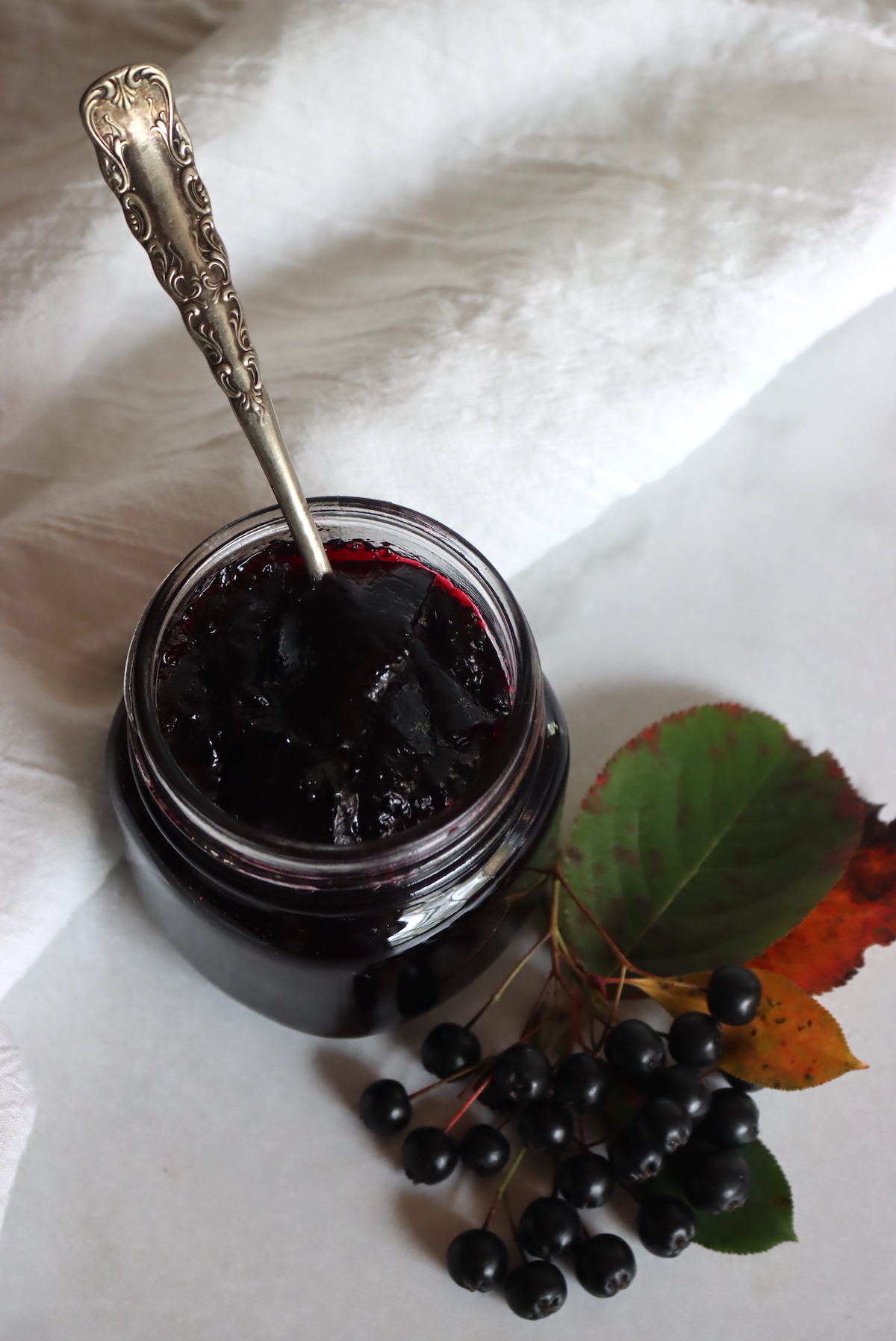
Aronia Recipes
I have a huge list of aronia recipes if you’re looking for all the options, but here are a few to get you started:
- Need an on-the-go snack? Try these vegan Aronia Oatmeal Crumble Bars from Vibrant Plate.
- Craft your own Aronia Berry Simple Syrup for all your favorite cocktails, desserts, and sauces with this easy recipe from Gastronom Cocktails.
- Put up any extra berries with this simple Aronia Jelly recipe from Creative Canning.
- Make your Black Chokeberries the star of the show with this Classic Aronia Berry Pie recipe from the American Aronia Berry Association.
- Get your ferment on with this homemade Aronia Wine Recipe.
- Make an easy-to-take tincture with this Simple Aronia Berry Tincture recipe.
Edible Wild Fruit and Berries
Looking for more tasty edible wild fruit?
- Foraging Bunchberries
- Foraging Barberry
- Foraging Rose Hips
- Foraging Rowanberry
- Foraging Autumn Olive
- Foraging Partridgeberry
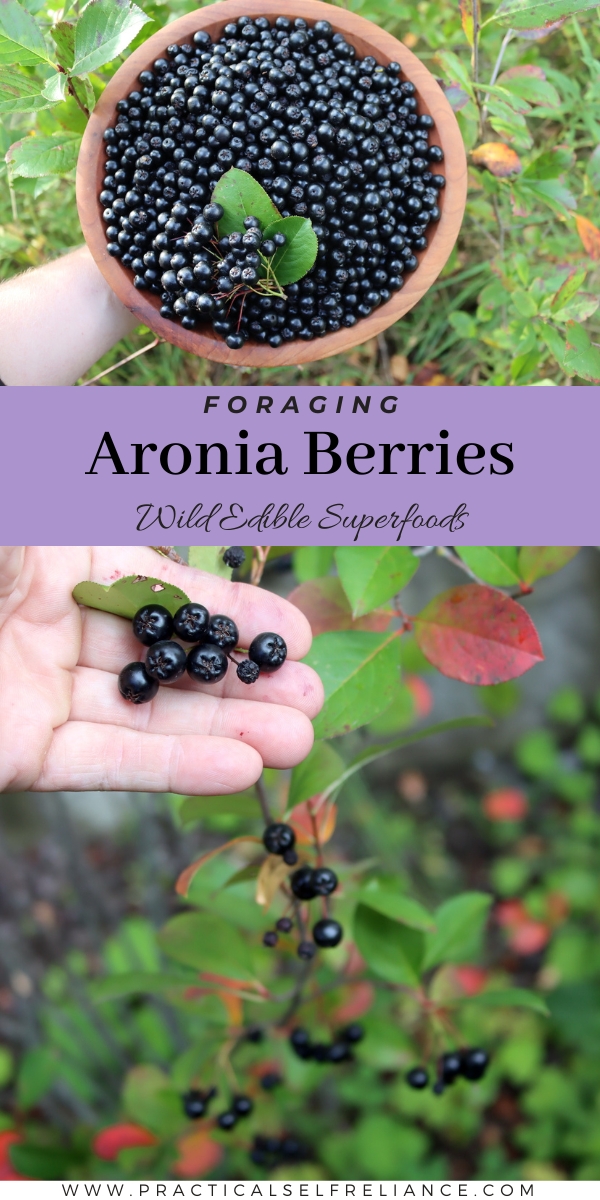


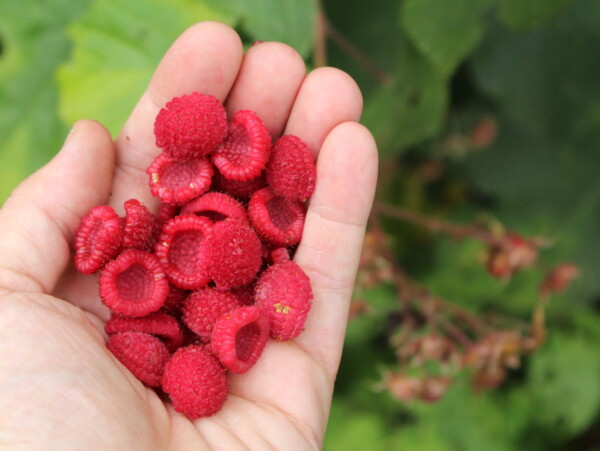
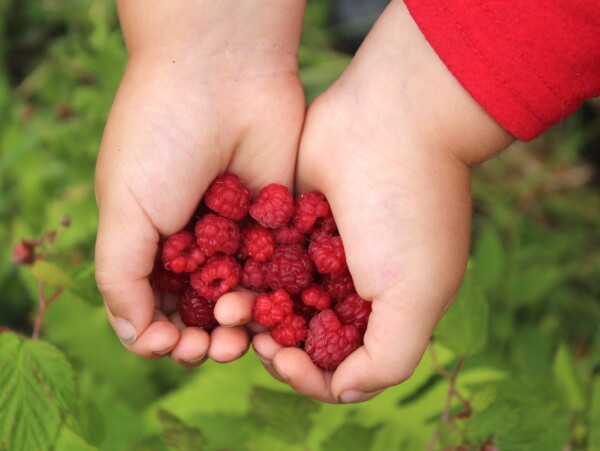
I wonder if you could preserve these in honey?
You could possibly do a fermented honey with them.
We went fishing at a new spot today & wouldn’t you know it, the dirt road across from the pond had bushes absolutely dripping with these fruits! 🤭✌️ Tomorrow’s homeschooling lesson will definitely be foraging black chokeberry! Thank you! 👏👏👏
We have wild firecracker plants with a red flower that bees and hummingbirds like. They have berries that are black when ripe. I read that they were edible so I have been picking and eating some. They are tasty but ascerbic – slightly sweet. Have you heard of them? Would like to know their nutritional value.
I have not actually heard of those before. They sounds very interesting though.
Hi,
I just harvested some aronia from a local park and made jam (or compote, because I put very little sugar) by adding a cup of blueberries to 2 1/2 cups of aronia. Then, I used a hand blender to smooth it all out. The result was amazing. It came out very thick and perfect to spread on toast, croissants, baguette and anything else you could think of.
That sounds really lovely. Thanks for sharing.
Ashley, Quite the coincidence coming across this post as I picked a small branch off a shrub in a local park. The leave have that fine serrated roundish shape and the berries are jet black, stems are individual for each berry. The only difference they don’t have the puckered look like your these are completely round. There doesn’t appear to be an attachment option to this post or I’d send along a picture. Bill
All the ones I’ve seen have had the pucker on the end, so it’s possible you have something different.
I even eat the leaves raw, they had no acidic or bad taste at all, tasted like acid-less protein or something. Wonder the antioxidant and nutritional value of the leaves.
Interesting. Thanks for sharing!
What do the seeds look like?
If you will scroll through this article from Friends of the Wildflower Garden you will see many pictures, including one with the seeds. https://www.friendsofthewildflowergarden.org/pages/plants/blackchokeberry.html
I’m not sure if this is what I found. The berries and plant look the same, but the berries taste way too astringent to eat raw and each has two or three seeds/stones. The bark on the bush looks like cherry but I am sure these are not choke cherries, as I have many choke cherry bushes and gather quite a bit. These are not starchy like cherries. Also, the skin is black but the inner fruit is the color of concord grapes.
I own a few acres in upstate New York and I have noticed a type of berry that I can’t 100% identify. They seem to me through research to be Chokeberry but I’m not completely sure and was looking for help with identification. The berries are small, maybe a tad smaller than pomegranate seeds, right now they have turned dark blue/purple. The stems have turned red as well as the edge of the leaves. The ground is swampy in the area and there’s lots of wild blackberries and raspberries around them. I’m just not sure if there is anything that look very similar that may be toxic. I do know what pokeweed is and I know they are not that. I do have a photo but can’t attach it. Any help would be greatly appreciated because I have a lot of them and I’d love to know if they’re edible.
There is a really great plant identification group on Facebook. You can post your picture there and they will ID it for you. https://www.facebook.com/groups/156706504394635 I also always recommend checking several other sources to confirm the identification. You can also check field guides and look for groups in your area that are knowledgeable in foraging and plant identification.
The size doesn’t sound like aronia. I’m wondering if it’s some sort of Viburnum.
Hi Ashley,
Thank you for your sharing on your site. I came across it a few times looking for things since my husband and I have land in the NEK and eventually will move up there from Milton so we will be the furthest from our one and only Vermont Trader Joes and Healthy living than we’ve ever been. We are doing our best to learn as much foraging as we can make use of on our land but are having a hard time finding help online or in person to give us some place to start. Is there any chance you or someone you know would be available for a 1-2 hour walk around up in Brownington in the near future to help do some berry IDing to set me on the path for investigating further? It looks like we have about at least 6 types of berries on the land (two are raspberries and blackberries) bu the rest are totally foreign to me. Please let me know what you think and if so what type of compensation would be agreeable. Thanks so much.
Hiw do you preserve choke berries. I have an abundant supply this year. Freeze them like blueberries ?
Yes, you can freeze them whole like blueberries. It depends on how you plan to use them. I juice them in a steam juicer and we’ve made wine with the juice, and I’ve thought about canning it. I’m not exactly sure on the pH and if it’s safe for water bath canning. One source says the juice has a pH 3.5, but really there’s limited information on canning them online.
This is all I could find from the Ag extension:
“There is little information about home juice extraction and
aronia product formulation. Juice extraction may be done in a
manner similar to that used for grapes. Hot extraction has been
reported to give a better-flavored product with less “green”
flavor and better color. This does slightly dilute the juice and
produce a juice lower in total acidity than is usually needed for
jam making or wine making. Adding acid could compensate for
the deficiency. The berries may be frozen and the juice
extracted later. Berries frozen before grinding or crushing may
produce higher juice yields. Sugar may need to be added to
juices or syrups to counteract the strong flavor of the tannins.”